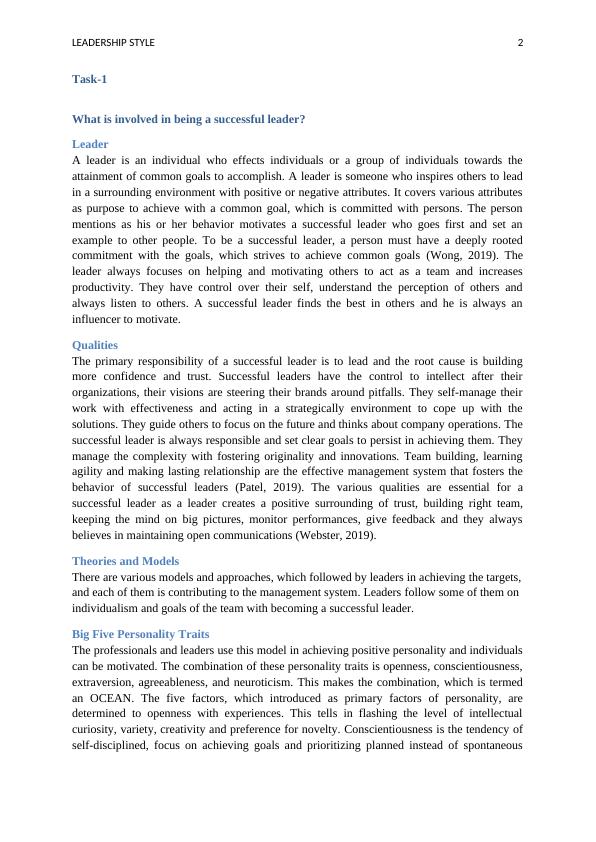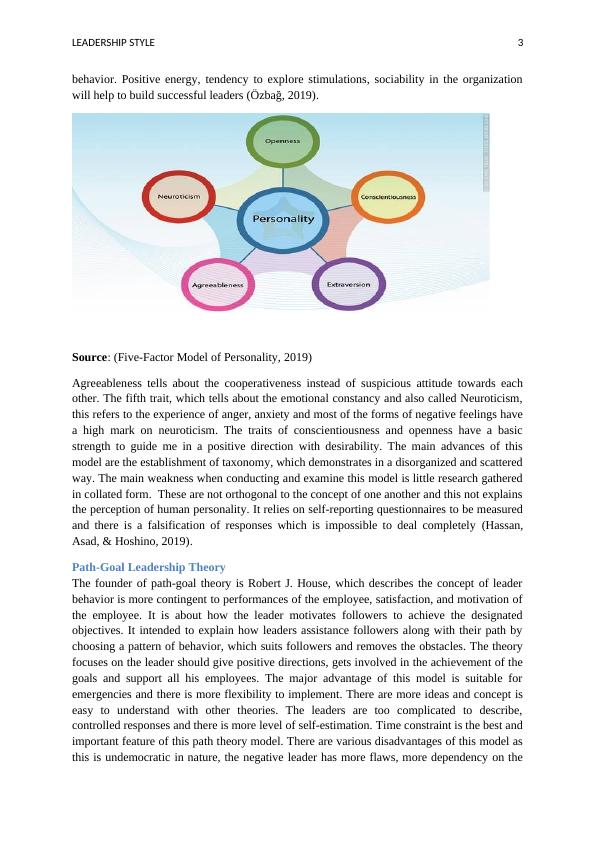Leadership Styles
Added on 2023-03-31
13 Pages3816 Words306 Views
RUNNING HEAD: LEADERSHIP STYLES 0
Leadership
Leadership

LEADERSHIP STYLE 1
Table of Contents
Task-1....................................................................................................................................................2
What is involved in being a successful leader?......................................................................................2
Leader................................................................................................................................................2
Qualities............................................................................................................................................2
Theories and Models.........................................................................................................................2
Big Five Personality Traits............................................................................................................2
Path-Goal Leadership Theory........................................................................................................3
Lewin’s Leadership Style..............................................................................................................4
Transformational Leadership.........................................................................................................4
Task- 2...................................................................................................................................................5
Can good leadership be developed, and if so, how?..............................................................................5
Pace Setter Leadership.......................................................................................................................5
Behavioural Theory.......................................................................................................................5
Servant Leadership........................................................................................................................5
Strengths-Based Leadership..........................................................................................................6
Task-3....................................................................................................................................................6
What distinguishes leadership from management?..............................................................................7
Management......................................................................................................................................7
Leadership.........................................................................................................................................7
Difference between Management and Leadership.............................................................................7
Examples...........................................................................................................................................8
Task- 4...................................................................................................................................................9
What have you learned about leadership from your own experiences, on this course and elsewhere?. .9
Bibliography........................................................................................................................................10
Table of Contents
Task-1....................................................................................................................................................2
What is involved in being a successful leader?......................................................................................2
Leader................................................................................................................................................2
Qualities............................................................................................................................................2
Theories and Models.........................................................................................................................2
Big Five Personality Traits............................................................................................................2
Path-Goal Leadership Theory........................................................................................................3
Lewin’s Leadership Style..............................................................................................................4
Transformational Leadership.........................................................................................................4
Task- 2...................................................................................................................................................5
Can good leadership be developed, and if so, how?..............................................................................5
Pace Setter Leadership.......................................................................................................................5
Behavioural Theory.......................................................................................................................5
Servant Leadership........................................................................................................................5
Strengths-Based Leadership..........................................................................................................6
Task-3....................................................................................................................................................6
What distinguishes leadership from management?..............................................................................7
Management......................................................................................................................................7
Leadership.........................................................................................................................................7
Difference between Management and Leadership.............................................................................7
Examples...........................................................................................................................................8
Task- 4...................................................................................................................................................9
What have you learned about leadership from your own experiences, on this course and elsewhere?. .9
Bibliography........................................................................................................................................10

LEADERSHIP STYLE 2
Task-1
What is involved in being a successful leader?
Leader
A leader is an individual who effects individuals or a group of individuals towards the
attainment of common goals to accomplish. A leader is someone who inspires others to lead
in a surrounding environment with positive or negative attributes. It covers various attributes
as purpose to achieve with a common goal, which is committed with persons. The person
mentions as his or her behavior motivates a successful leader who goes first and set an
example to other people. To be a successful leader, a person must have a deeply rooted
commitment with the goals, which strives to achieve common goals (Wong, 2019). The
leader always focuses on helping and motivating others to act as a team and increases
productivity. They have control over their self, understand the perception of others and
always listen to others. A successful leader finds the best in others and he is always an
influencer to motivate.
Qualities
The primary responsibility of a successful leader is to lead and the root cause is building
more confidence and trust. Successful leaders have the control to intellect after their
organizations, their visions are steering their brands around pitfalls. They self-manage their
work with effectiveness and acting in a strategically environment to cope up with the
solutions. They guide others to focus on the future and thinks about company operations. The
successful leader is always responsible and set clear goals to persist in achieving them. They
manage the complexity with fostering originality and innovations. Team building, learning
agility and making lasting relationship are the effective management system that fosters the
behavior of successful leaders (Patel, 2019). The various qualities are essential for a
successful leader as a leader creates a positive surrounding of trust, building right team,
keeping the mind on big pictures, monitor performances, give feedback and they always
believes in maintaining open communications (Webster, 2019).
Theories and Models
There are various models and approaches, which followed by leaders in achieving the targets,
and each of them is contributing to the management system. Leaders follow some of them on
individualism and goals of the team with becoming a successful leader.
Big Five Personality Traits
The professionals and leaders use this model in achieving positive personality and individuals
can be motivated. The combination of these personality traits is openness, conscientiousness,
extraversion, agreeableness, and neuroticism. This makes the combination, which is termed
an OCEAN. The five factors, which introduced as primary factors of personality, are
determined to openness with experiences. This tells in flashing the level of intellectual
curiosity, variety, creativity and preference for novelty. Conscientiousness is the tendency of
self-disciplined, focus on achieving goals and prioritizing planned instead of spontaneous
Task-1
What is involved in being a successful leader?
Leader
A leader is an individual who effects individuals or a group of individuals towards the
attainment of common goals to accomplish. A leader is someone who inspires others to lead
in a surrounding environment with positive or negative attributes. It covers various attributes
as purpose to achieve with a common goal, which is committed with persons. The person
mentions as his or her behavior motivates a successful leader who goes first and set an
example to other people. To be a successful leader, a person must have a deeply rooted
commitment with the goals, which strives to achieve common goals (Wong, 2019). The
leader always focuses on helping and motivating others to act as a team and increases
productivity. They have control over their self, understand the perception of others and
always listen to others. A successful leader finds the best in others and he is always an
influencer to motivate.
Qualities
The primary responsibility of a successful leader is to lead and the root cause is building
more confidence and trust. Successful leaders have the control to intellect after their
organizations, their visions are steering their brands around pitfalls. They self-manage their
work with effectiveness and acting in a strategically environment to cope up with the
solutions. They guide others to focus on the future and thinks about company operations. The
successful leader is always responsible and set clear goals to persist in achieving them. They
manage the complexity with fostering originality and innovations. Team building, learning
agility and making lasting relationship are the effective management system that fosters the
behavior of successful leaders (Patel, 2019). The various qualities are essential for a
successful leader as a leader creates a positive surrounding of trust, building right team,
keeping the mind on big pictures, monitor performances, give feedback and they always
believes in maintaining open communications (Webster, 2019).
Theories and Models
There are various models and approaches, which followed by leaders in achieving the targets,
and each of them is contributing to the management system. Leaders follow some of them on
individualism and goals of the team with becoming a successful leader.
Big Five Personality Traits
The professionals and leaders use this model in achieving positive personality and individuals
can be motivated. The combination of these personality traits is openness, conscientiousness,
extraversion, agreeableness, and neuroticism. This makes the combination, which is termed
an OCEAN. The five factors, which introduced as primary factors of personality, are
determined to openness with experiences. This tells in flashing the level of intellectual
curiosity, variety, creativity and preference for novelty. Conscientiousness is the tendency of
self-disciplined, focus on achieving goals and prioritizing planned instead of spontaneous

LEADERSHIP STYLE 3
behavior. Positive energy, tendency to explore stimulations, sociability in the organization
will help to build successful leaders (Özbağ, 2019).
Source: (Five-Factor Model of Personality, 2019)
Agreeableness tells about the cooperativeness instead of suspicious attitude towards each
other. The fifth trait, which tells about the emotional constancy and also called Neuroticism,
this refers to the experience of anger, anxiety and most of the forms of negative feelings have
a high mark on neuroticism. The traits of conscientiousness and openness have a basic
strength to guide me in a positive direction with desirability. The main advances of this
model are the establishment of taxonomy, which demonstrates in a disorganized and scattered
way. The main weakness when conducting and examine this model is little research gathered
in collated form. These are not orthogonal to the concept of one another and this not explains
the perception of human personality. It relies on self-reporting questionnaires to be measured
and there is a falsification of responses which is impossible to deal completely (Hassan,
Asad, & Hoshino, 2019).
Path-Goal Leadership Theory
The founder of path-goal theory is Robert J. House, which describes the concept of leader
behavior is more contingent to performances of the employee, satisfaction, and motivation of
the employee. It is about how the leader motivates followers to achieve the designated
objectives. It intended to explain how leaders assistance followers along with their path by
choosing a pattern of behavior, which suits followers and removes the obstacles. The theory
focuses on the leader should give positive directions, gets involved in the achievement of the
goals and support all his employees. The major advantage of this model is suitable for
emergencies and there is more flexibility to implement. There are more ideas and concept is
easy to understand with other theories. The leaders are too complicated to describe,
controlled responses and there is more level of self-estimation. Time constraint is the best and
important feature of this path theory model. There are various disadvantages of this model as
this is undemocratic in nature, the negative leader has more flaws, more dependency on the
behavior. Positive energy, tendency to explore stimulations, sociability in the organization
will help to build successful leaders (Özbağ, 2019).
Source: (Five-Factor Model of Personality, 2019)
Agreeableness tells about the cooperativeness instead of suspicious attitude towards each
other. The fifth trait, which tells about the emotional constancy and also called Neuroticism,
this refers to the experience of anger, anxiety and most of the forms of negative feelings have
a high mark on neuroticism. The traits of conscientiousness and openness have a basic
strength to guide me in a positive direction with desirability. The main advances of this
model are the establishment of taxonomy, which demonstrates in a disorganized and scattered
way. The main weakness when conducting and examine this model is little research gathered
in collated form. These are not orthogonal to the concept of one another and this not explains
the perception of human personality. It relies on self-reporting questionnaires to be measured
and there is a falsification of responses which is impossible to deal completely (Hassan,
Asad, & Hoshino, 2019).
Path-Goal Leadership Theory
The founder of path-goal theory is Robert J. House, which describes the concept of leader
behavior is more contingent to performances of the employee, satisfaction, and motivation of
the employee. It is about how the leader motivates followers to achieve the designated
objectives. It intended to explain how leaders assistance followers along with their path by
choosing a pattern of behavior, which suits followers and removes the obstacles. The theory
focuses on the leader should give positive directions, gets involved in the achievement of the
goals and support all his employees. The major advantage of this model is suitable for
emergencies and there is more flexibility to implement. There are more ideas and concept is
easy to understand with other theories. The leaders are too complicated to describe,
controlled responses and there is more level of self-estimation. Time constraint is the best and
important feature of this path theory model. There are various disadvantages of this model as
this is undemocratic in nature, the negative leader has more flaws, more dependency on the

End of preview
Want to access all the pages? Upload your documents or become a member.
Related Documents
Introduction to Management: Traits of Effective Leaders and Leadership Theorieslg...
|12
|2657
|84
Leadership and Management- Doclg...
|17
|4202
|458
Leadership Theorieslg...
|11
|2336
|108
Leadership Approaches, Theories & Modelslg...
|2
|869
|47
Group Projectlg...
|19
|5816
|99
Leadership QUESTION 1 4 Requirements and considerationslg...
|15
|4294
|79
